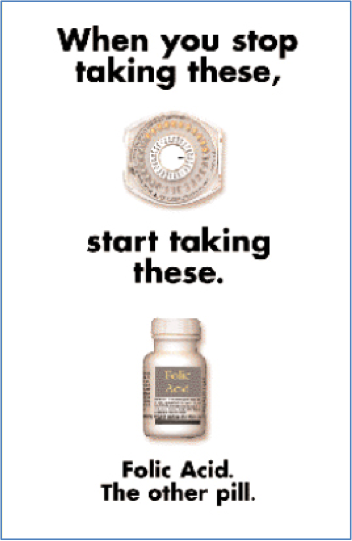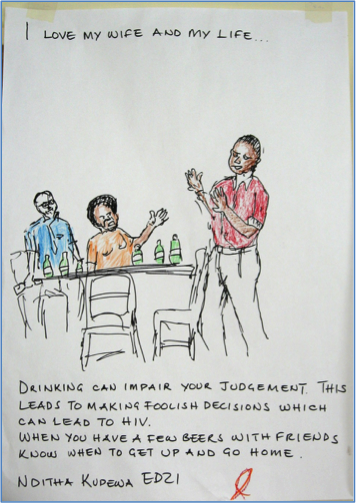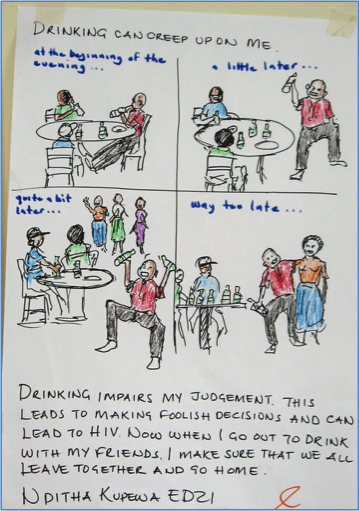Introduction
What is a Creative Concept?
A creative concept is an overarching “Big Idea” that captures audience interest, influences their emotional response and inspires them to take action. It is a unifying theme that can be used across all campaign messages, calls to action, communication channels and audiences. Typically, the creative concept is embodied in a headline, tagline and a key visual. Successful creative concepts are distinctive, memorable, unifying and relevant. Some examples include: Nike’s “Just Do It” campaign, the “Got Milk?” campaign and the Red Ribbon Campaign.
| The “Big Idea” behind the UNICEF Tap Project was to brand tap water in New York City. The campaign asked restaurant diners to donate $1 for the tap water restaurants usually serve free of charge. Diners were told that their $1 donation would provide clean, safe water to a child for 40 days. |
Creative concepts are based on the communication strategy and creative brief. This ensures that concepts are informed by a strong understanding of the situation, the audience, the channels that will be used, the objectives the campaign seeks to reach and the benefits the audience will respond to. The creative team develops multiple creative concepts based on this information and then concept tests them to determine which one resonates best with the audience.
| The Green Star campaign in Tanzania developed several creative concepts for their family planning campaign. The winning concept was to recognize anybody who was positively involved with family planning as a star. The concept could be used across audiences. For example, married couples who decided together which method to use were stars, media houses that reported accurately on family planning were stars and dedicated family planning service providers were stars. The concept worked across many channels, including print, community and mobile. |
What is NOT a Creative Concept?
Creative concepts are NOT final products. They are rough drafts that give an idea of how the campaign could take shape. Keeping this in mind, creative concepts are not:
| Different colors or fonts | These are graphic design elements that will be developed in the executions (materials) after concept testing. Colors and fonts should be tested during the pretesting stage. |
| Different models | Concepts typically use stock photography or rough illustrations to convey the general idea. Talent selection for the actual models to be used in the final executions can be older/younger/shorter/ taller/happier/more serious. Models should be tested during pretesting, once the concept is solidified. |
| Different informational messages or calls to action | The concept should be strong and overarching enough to work for all messages/calls to action. |
Why Develop a Creative Concept?
In today’s busy and constantly changing communication environment, social and behavior change communication (SBCC) must be creative and strategic to compete with commercial advertising and capture the audience’s attention. The creative concept shapes the core of the SBCC campaign, which helps create consistency across messages and materials. Developing creative concepts is also important because it allows the team to:
- Test which benefit is most appealing to the audience
- See how the campaign will work (or not) across multiple media channels
- Identify an idea that ties the whole campaign together
- Reach the audience more effectively by finding ‘big ideas’ that resonate with them
Who Should Generate the Creative Concept?
There are different approaches to generating creative concepts. One approach is to outsource creative development to an advertising or creative agency. The creative agencies develop several concepts and test them with the audience. Often, a committee made up of SBCC and government professionals reviews the concepts and makes a final decision based on concept test results and campaign objectives. Another option is to hold a design workshop with multiple stakeholders, including SBCC professionals, technical/topical experts, service delivery partners, government officials, multi-sectoral bodies, audience members and a creative team, including creative directors, graphic designers, illustrators, script writers, copy writers, producers, actors and musicians. During the design workshop, the participants review the creative brief and hold creative concept brainstorming sessions. The team needs a leader and it is sometimes helpful to have a creative expert facilitate the exercise.
When Should the Creative Concept Be Developed?
The creative brief marks the beginning of the creative process and acts as a “creative contract” agreed upon by all partners. The creative brief provides a road map for developing the creative concepts. Materials and activities are developed based on the winning creative concept.
Learning Objectives
After completing the activities in the creative concept guide, the team will:
- Produce a set of creative concepts based on research findings and strategic insights
- Select and refine the ideas that best support the SBCC strategy and creative brief
Estimated Time Needed
Developing a creative concept can take anywhere from a few days to two months depending on who is on the team, how experienced team members are at creating campaign concepts, campaign size and number of channels selected, time needed for individual brains
Prerequisites
Steps
Step 1: Develop a Problem Statement
Before holding a brainstorming session, develop a problem statement based on information in the creative brief and the communication strategy. It may help to review and revise (as necessary) the problem statement developed during the situation analysis. A problem statement is a concise description of the issue that needs to be addressed by the SBCC campaign. It answers three questions:
- What is the problem or communication challenge to be addressed? This explains why the communication campaign is needed. [Example: Low uptake of family planning services]
- Who has the problem? This describes the audience to be reached. [Example: Young married women ages 15 – 24 in Kirongo region]
- What will the audience do as a result of the campaign? This will explain how the project will measure success. [Example: Speak to a health worker about contraceptives]
| Sample problem statementEven though services are available, very few young married women in Kirongo region use modern contraception. This campaign will inspire young married women ages 15-24 in Kirongo to talk with a health worker about contraceptives. |
Step 2: Select the Brainstorm Team
Assemble a team to conduct a creative concepts brainstorm. If outsourcing, creative agency staff may do the brainstorming. If conducting a design workshop, be sure to invite members from a variety of backgrounds, including government staff, creative professionals, SBCC experts and technical experts. Clarify the team member roles before brainstorming sessions begin:
- Team leader: responsible for developing the problem statement and inviting people to the brainstorm, presents the problem statement with background information.
- Facilitator: leads the brainstorm, encourages full participation and the flow of ideas, and keeps the group focused on the task. The facilitator must be familiar with the creative brief, situation analysis, communication strategy and other background information.
- Note taker: writes down ideas generated during the brainstorm, recalls ideas during the session as requested and compiles the notes into a [brief] report.
- Team members: share ideas even if they seem unlikely or crazy, respect the contributions of others and actively participate in the brainstorm session.
Step 3: Organize the Brainstorming Session
Arrange a time and place for the session and invite participants. Ensure that the room is comfortable and has markers and a flip chart, white board or blank paper to capture ideas. To encourage creativity, it may be helpful to decorate the room, provide toys to play with or play fun music.
Participants are more likely to be creative if their minds are open and prepared for brainstorming. When inviting participants, include any tasks they should do before arriving at the brainstorming session. For example, it may help them to read or view something inspirational, try something new or interrupt their usual routines.
Step 4: Provide Background for the Brainstorm
At the beginning of the brainstorm session, the facilitator states the objectives and expected outcomes of the meeting to create a common purpose. The facilitator then outlines what will happen in the meeting and the methods that will be used, such as individual idea generation, group brainstorming, small group work or critique sessions.
Next, the facilitator helps the participants set ground rules for the brainstorm. For example:
- Quantity over quality
- No idea is a bad idea
- Only one person can talk at a time
- Present ideas as quickly as possible
- No comments on any of the ideas during the brainstorm
Remind participants of what they have agreed to by posting these rules around the room. The facilitator will likely need to guide participants to follow the rules.
The team leader (or facilitator) then presents the problem statement and key points from the creative brief. Team members, including partners, share summaries of research findings from the analyses conducted. This will help ground the idea generation, making it more strategic.
Step 5: Break the Ice
To produce creative ideas, participants need to open their minds and feel comfortable with each other. A silly ice breaker or fun activity can help participants get in a creative mind-set and not be as concerned about what others think of them. See the Resources section for links to ice breakers and other activities.
There are many ways to conduct a brainstorm session for creative concepts. The following steps present one common method. Choose a method that works best for your group of participants.
Step 6: Individual Idea Generation
Start by giving participants a set amount of time to generate ideas individually (30 minutes is usually good). Provide individuals with sticky notes and ask them to think of themes or ideas that would encourage the desired change and communicate a benefit for making that change. Usually, this stage involves coming up with an image or overarching idea, but individuals may think of a headline or tagline, as well. Individuals can draw, write or express their ideas in other fun ways on their sticky notes.
| The purpose is to generate as many ideas as possible. Encourage all ideas, not just “good” ones; ideas tend to get better as the session progresses. Remind participants that now is not the time to evaluate their ideas. Taking time to sort good from bad will break their creative momentum. |
Once the time limit is reached, ask everyone to put their sticky notes up on a board. If time allows, participants can read their ideas out loud as they put them on the board. Then let participants walk around so they can see all the ideas up on the boards. If the group is smaller, the facilitator can ask everyone to work together to group the ideas. If the group is large, assign a few people to group them.
Step 7: Expand Ideas
Next, expand on the groups of creative ideas. This is often done in small groups, but it also can be done all together, especially if the group is small. Divide the participants into small groups of three or four, ensuring a good mix of backgrounds (creative, technical, communication, government). Assign each a grouping and ask them to further develop that creative idea. The small groups should come up with a visual and a headline, slogan or tagline that goes along with the visual. Set a time limit and remind participants of the ground rules.
The facilitator can provide participants with methods for expanding on ideas, such as:
- Dissection: Take the idea apart and discuss how to improve or change each part.
- SCAMPER: Think of ways to substitute, combine, adapt, modify, put to another use, eliminate or reverse the idea.
- Challenge assumptions: Ask what assumptions the idea makes and challenge them. Dig deeper to challenge the way the group views the problem and the audience.
- Opposites: Ask what is the opposite of the idea and whether it could work.
- “Yes, and…”: Read the idea aloud. Then, say, “yes, and…”, adding a new piece to the idea.
| A campaign to reduce concurrent sexual partnerships developed two top concepts. 1. Tagline: “Some things are not meant to be shared.” The concept involved people sharing unexpected items like sugarcane, gum, and toothbrushes. 2. Tagline: “How many are we?” The concept involved presenting scenarios where a couple thinks they are alone (car, restaurant, bedroom). Additional characters would continue to enter the scene, creating obvious romantic linkages to the main characters and each other. The couple ends up thinking, “Is it really just the two of us, or are we many more?” |
When the time is up, each group presents their ideas to the larger group. During presentations, participants can help refine ideas using positive phrases like, “Yes, and…” The note taker should record every idea presented. Ideas can be written on a white board or flipchart, recorded using visual notes or graphic recording, or captured using various applications and software.
| If participants get stuck during a brainstorm, the facilitator can encourage creativity using various techniques: |
|
Step 8: Select and Refine the Two to Three Best Ideas
Once all of the ideas have been presented, the facilitator leads participants in an exercise to identify the strongest ones. The facilitator may have participants fill out a rating matrix (see Templates for an example), or vote on the best ideas using a dot vote or other method. Participants should keep the following criteria in mind when selecting ideas:
- Does it follow the creative brief and communication strategy?
- Is it appropriate for the audience?
- Does it address the communication objectives, key benefits and barriers?
- Can it be rolled out in multiple ways across several media channels?
- Is it ‘fresh’, new, outside the box? Does it capture attention?
- Does it have the potential for expansion?
The facilitator reviews the results and identifies the top three ideas. Using methods like Round Robin and 6 Thinking Hats, the facilitator then helps the group to refine the top ideas into final creative concepts. Some questions to consider include:
- What are the good and challenging/potentially problematic aspects of this idea?
- How might we fix the challenging aspects?
- How can this idea be presented in a way that makes it real for the audience?
- How can this idea work throughout the campaign/program/strategy?
Step 9: Check Feasibility
After the brainstorming session, check the three final concepts again to ensure they are feasible and consistent with the creative brief. For each, consider each of these questions:
- Will this work?
- Will it interest the audience? Would it offend any audience members?
- Is budget sufficient to support the idea?
- Can this idea be promoted through the communication channels selected for this program/campaign?
For each viable concept, search the Internet and query personal contacts to ensure the idea is not already in use by another organization or for another issue.
Step 10: Prepare Visual Presentations of Concepts
The creative team now develops the final three concepts visually and verbally so that they can be tested with the audience. The most common approach is to develop a concept board containing a headline, tagline and a key visual. The visual is an image that complements the idea and serves as a catalyst for discussion. Concept boards can be illustrated or stock photography can be used. Sometimes the concepts can be presented through a storyboard for a TV spot, an outline of a radio spot or a written description of how the concept would roll out across multiple media. Below are a couple examples of concept boards. See the Samples section for more.
For Folic Acid use:


For controlling alochol consumption:


Creative concepts are rough drafts – just enough to convey an idea. The team can use electronic presentations to develop them, with stock photos or basic images, or they can draw basic figures on paper. Once developed, it is helpful to present the concepts to the original group of participants to vet them. Then, the concepts are tested with the audience to get feedback before developing materials.
Templates
Creative Concept Rating Matrix Template
Samples
Alive & Thrive Infant and Young Child Feeding Community-based Support Group Model in Viet Nam
Creative Concept Mockup Example
External Resources
http://www.ted.com/talks/tim_brown_on_creativity_and_play)
http://www.ted.com/talks/amy_tan_on_creativity
http://www.ted.com/talks/david_kelley_how_to_build_your_creative_confidence
http://scottberkun.com/essays/34-how-to-run-a-brainstorming-meeting/
Tips & Recommendations
- Before brainstorming, participants should open their minds to inspiration from the world around them. Some ways to do this include:
- Read a novel, look at magazines and newspapers, or visit websites.
- Change normal routines—work from a new location, listen to a different radio station, interact with new people or do things in a different order.
- Talk to people in different fields to learn about the creative ideas that have worked for them, and think about how these ideas might apply.
- Look at examples from other countries to spark ideas.
- Hold the brainstorming session in a creative environment. Decorate the room with unique objects, such as sculptures, architectural models and toys, photographs or drawings that may spark creative thinking. Play unusual music as the session begins and during breaks.
- Mix up small groups, making sure there are creative, technical, communication and government people in each brainstorming group.
- Do not get discouraged if the first brainstorming session fails to produce good ideas. Hold another session with different participants.
- Do not evaluate ideas when they are presented. It kills the new ideas.
Lessons Learned
- Many people think they are not creative, and divide the world into creative and non-creative people. This is not the case and creative concept team members need to believe in their ability to be creative. Facilitators can nurture this self-confidence by offering encouragement and a non-judgmental attitude.
- Most people fear the judgment of their peers, even at work. This fear causes people to think and speak conservatively. They might have a wild idea, but are afraid to share it. Helping people feel secure by providing a trusted environment makes it more likely they will feel free to express their ideas.
- Let people brainstorm in whatever language they feel most comfortable.
- During brainstorming, focus on the quantity of ideas, not the quality. When people come up with as many ideas as possible in the shortest time allowed, they are more likely to innovate.
- Brainstorming generates much more creative outcomes when everybody follows agreed-upon rules. It helps to post brainstorming rules on the walls—things like: “defer judgment,” “go for quantity” or “think big.” Providing written rules helps people break old rules and norms that they might bring to the creative process.
- When leaders and facilitators start out sharing bad or silly ideas, it frees other participants to speak their ideas. It is critical to have an environment where everybody feels comfortable sharing their ideas.
- A good facilitator is essential to a productive brainstorming session. Choose a facilitator with good listening skills, sharp group awareness and the ability to help people express their ideas, especially those who are usually quieter.
Glossary & Concepts
- Communication challenge: The gap between what a group of people is doing and what they should be doing to correct a health problem. This gap is what a communication campaign is designed to address.
- Concept board: A visual representation of an idea that usually contains a headline, visual and tagline.
- Creative brief: A short document outlining the audience, objective, promise, key message content and the communication channels that will be used—a succinct account of a campaign strategy.
- Creative concept: The overarching artistic theme that ties together all elements of an SBCC campaign. It is an imaginative plan for capturing the audience’s heart and mind.
- Headline: The lead line that is usually at the top of a print execution with the most prominence.
- Tagline: A phrase or slogan that identifies a product or behavior. Taglines are short and memorable. They give the audience a reason to do what they are being asked to do.
- Problem statement: A concise description of the issue that the communication campaign will address. It should indicate why a communication campaign is needed, the people who are affected and the behavior(s) those people should adopt.
- Stock photography: Photographs of common people, places, landmarks or things that can be bought and used for design purposes. Typically, they are used to save money on a photographer.
- Storyboard: A set of illustrated panels, displayed in sequence, which visually tells a story. A storyboard shows what happens in a story by drawing out the contents of the story.
- Stakeholders: Those who are affected by, have a direct interest in or are somehow involved with the health or social problem.
Resources and References
Resources
Developing and Testing Creative Concepts
References
- Mark W. Stuhlfaut & Chan Yun Yoo, A tool for evaluating advertising concepts: Desirable characteristics as viewed by creative practitioners, Journal of Marketing Communications, Volume 19, Issue 2, 2013, pages 81-97, http://www.tandfonline.com/doi/abs/10.1080/13527266.2010.550009 (accessed May 2015)
- Swee Hoon Anga, Siew Meng Leonga*, Yih Hwai Leea & Seng Lee Loua Necessary but not sufficient: Beyond novelty in advertising creativity, Journal of Marketing Communications, Volume 20, Issue 3, 2014, pages 214-230. http://www.tandfonline.com/doi/abs/10.1080/13527266.2012.677464?src=recsys#.VVXMndGJjcs (accessed May 2015)
- Erin Schreiner, The difference between advertising campaigns, strategies and concepts. http://smallbusiness.chron.com/difference-between-advertising-campaigns-strategies-concepts-17682.html (accessed May 2015)
- Riku Vassinen, The seven characteristics of the great concept, Stand Up Strategy, http://standupstrategy.org/2012/07/11/the-seven-characteristics-of-the-g… (accessed May 2015)
Banner Photo: © 2011 Katherine Lin/Johns Hopkins Bloomberg School of Public Health, Courtesy of Photoshare
